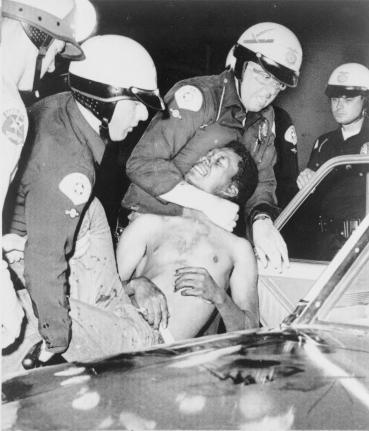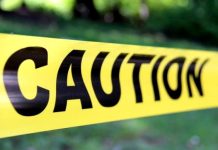WASHINGTON, Aug. 11 (UPI) — On Aug. 11, 1965, a fight erupted as police in Los Angeles arrested an African-American man in an incident that sparked racially charged protests, the message of which would be echoed by the Black Lives Matter movement 50 years later.
It’s the 50th anniversary of the day Marquette Frye, 21, was pulled over by a California highway patrolman for drunk driving, and things turned violent. The confrontation would result in six days of deadly rioting and looting later to be known as the Watts Riots or Watts Rebellion.
The conflict between the predominantly African-American Watts neighborhood in south Los Angeles and law enforcement would ultimately result in 34 deaths, thousands of injuries and more than $40 million in property damage.
It’s a story that would repeat itself in 1992 when Los Angeles police were filmed beating Rodney King. And it’s a story that would repeat itself — with less destruction and fewer casualties — when Michael Brown was shot to death in Ferguson, Mo., when Eric Garner died after being put in a chokehold by a New York police officer and whenFreddie Gray‘s neck broke after an alleged “rough ride” in a Baltimore police van.
Hundreds of people in south Los Angeles turned on police the night of Aug. 11, 1965, when a fight broke out between Frye, his family and officers on the scene. A brief UPI article from the day said a “near riot was touched off” as hundreds of people gathered, some throwing rocks. At least one woman was hospitalized.
One day later, the crowd of protesters swelled to 200 to 300 youths, who fired on police officers, burned cars, and hurled rocks and bottles. The California National Guard was put on alert and by Aug. 13, they deployed to the city.
Though black leaders in the community called for an end to riots and the looting of white-owned stores, the violence would continue until Aug. 17. Before it was all over, more than 500 businesses and private buildings were looted, damaged, burned or all three; more than 250 were destroyed. At least one public building was also destroyed and a dozen damaged or burned.
“Smoke covered the skyline, telling a story Los Angeles will not soon forget,” one UPI reporter wrote Aug. 14.
The violence ended by Aug. 17 and Gov. Pat Brown — father of current California Gov.Jerry Brown — created a commission to investigate the circumstances that touched off the riots. The commission, led by former CIA Director John McCone, returned a reportin December of that year, largely blaming high unemployment, poor education and substandard living conditions among the African-American communities for the riots.
Racial bias among law enforcement and the judicial system was overlooked, a Los Angeles Times editorial published Friday said.
“The commission was too ready to assign the blame to migration of rural poor black Southerners to Los Angeles, bringing little education and little ability to make a living in the city,” the editorial read. “The commission spoke of race but not of racism. It noted that in African-American housing, employment and wages, Los Angeles was the best city in the nation. It said little about, or outright denied, the existence of policing practices meant to humiliate, prisons geared toward punishment without rehabilitation, political processes that systematically excluded African Americans from political representation.”
The commission suggested a number of reforms to combat the problems it saw as the cause of violence and crime in the city. A new hospital — the Martin Luther King Jr. medical center — and new schools were built, in addition to affordable housing projects.
“They all went through their own dull, devastating spirals of failure,” the Times said.
Five decades later and community leaders are once again trying to revitalize south Los Angeles. A new Martin Luther King Jr. Community Hospital has been built and a charter school operator has taken over the high school that serves the Watts community.
It’s unclear what kind of future lies ahead for the city as yet another generation tackles racism in the United States.
In the wake of protests over the deaths of black men at the hands of white police officers in the past year, again investigations have been launched, reports have been written. This time the focus has been turned inward on law enforcement.
In March, the U.S. Department of Justice found systemic racial discrimination in both law enforcement and the judicial system in Ferguson. Some officers sent racist emails and disproportionately targeted black people for traffic stops, it said. A report released in July found the St. Louis County Family Court — which serves Ferguson — also violated the constitutional right to due process for black youth.
The American Civil Liberties Union and the UN have also added their voices to the mix, criticizing a nationwide trend of police officers using excessive — and at times lethal — force against people of color
“We urge a comprehensive examination of all laws that could have discriminatory impact on African Americans to ensure that such laws are in full compliance with the country’s legal obligations and relevant international standards,” said Mireille Fanon Mendes France, head of the U.N. Working Group of Experts on People of African Descent.







